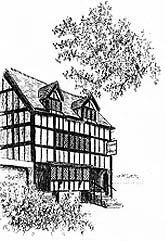|

Introduction
There is no doubt about the fact that Shrewsbury is an English town
that we should be proud of. Its location on a hill. with the river
creating an almost complete loop for protection, its mediaeval charm
with a wealth of timber-framed buildings. some of which lean so crazily
that I'm surprised they still stand, and its history which seems to be
almost visible, are all things which make Shrewsbury unique.
But
that's not to say it doesn't have its faults. Its position in the loop
of the river is the main cause of the traffic problems of today, and
its mediaeval charm is a continuous cause for concern and discussion
when any developer makes a move towards the town. And even its history
has caused controversy over the years amongst those puritans who do not
wish to mix fact and fiction in Shrewsbury.
Early
History
For a town with so much history, its origins are not as clear as one
would expect. Some believe that Shrewsbury owes its origins to the
Britons who deserted Viriconium on the banks of the Severn a few miles
downstream and found refuge from the invading Saxons at a place they
called Pengwern, from where, later, the Prince of Powys ruled his lands.
But
is that true? Some think that Pengwern
was more likely to have been further north, near Baschurch, at a place
they call The Berth. If that is true then Shrewsbury did not come into
being until later, when Offa the Terrible put his mark on our county in
the eighth century.
King
Offa
built a dyke to act as a dynastic boundary between Mercia (England) and
Powys (Wales). By the time Offa died at the end of the 8th century,
there had been a settlement where Shrewsbury stands today for quite a
long time. The obvious reasons for the choice of site were, the almost
complete loop of the river for defence, and, the river for
transportation. But we have to wait until 901 before Shrewsbury is
actually mentioned in a charter. 'acta
es, . . . in civitate Scrobbensi'. The
words indicate a defensive administrative centre exercising control
over a considerable area.
By 925, Athelstan, the first Saxon King of Britain, passed a law to
unify coinage, and Shrewsbury was one of the places thought suitable to
mint the new unified coins. At the end of the 9th century, Alfred was
on the throne and Shrewsbury would have consisted of little more than a
wooden tower and stockade on its highest point, perhaps where the
castle stands today. Ethelfleda, daughter of Alfred, is said to have
founded St. Alkmund's church, dedicated to a prince of the Royal house
of Northumbria.
But where did the name come from?
Some
historians believe that the name Scrob is derived from scrub or shrub,
mainly the latter so that it can be interpreted as the town of shrubs.
But others believe that it comes from a personal name, after all, there
was a Richard le Scrob, a pre-Conquest Norman who built Richard's
Castle (near Ludlow) and who administered this part of the border
region.
But is it Shrewsbury or Shrowsbury? The traditional pronunciation of
the 'ew' in Shrewsbury survives in the word 'sew'. In earlier days when
spelling was more phonetic the name appears as Shroesbury and
Shrowesbury, the 'ow" being sounded as in 'show'. It is a very handsome
word when thus enunciated and befitting of such a beautiful mediaeval
town. But just to confuse the visitor, you will find the locals
pronouncing it both ways!
After the Norman Conquest
It is said that in one day in September, 1066, a kingdom was lost and
won. The winner was, of course, William 'the Conqueror'. But
'conquering' the Welsh border region was not as easy as he would have
liked. One of the main objectors to the new regime was Edric
Sylvaticus, a Saxon who controlled large estates in Shropshire and
Hereford. He has passed into history as Wild
Edric, and in an alliance with
the Welsh he even besieged Shrewsbury in 1069.
Eventually
he was captured but instead of being punished he was given lands along
the border, the theory being that the problematic Welsh would now be
his problem. But it was a problem that would not go away, and
Shrewsbury soon became an important town in the control of the border
region known as The Marches.
The job of controlling this area was given to the Norman Earl Roger de
Montgomery, son of William's cousin. Roger was the first Earl of
Shrewsbury, and one of his first tasks was to replace the earlier
wooden fort with something more substantial. The castle still stands
today, although it has been altered considerably over the centuries,
and the oldest parts now visible probably date from the time of Henry
II in the 12th century.
Earl
Roger has passed into history as one of the 'good guys', unlike some
who followed him, and it is known he was a religious man as he founded
Shrewsbury Abbey, the remnants of which today are only a tiny part of a
vast complex with the church itself being over 300 feet (almost 100
metres) in length.
But such a building programme did have its opponents as houses and
buildings were knocked down to make way for Roger's new town. These
objections, amongst other interesting facts about 11th century
Shrewsbury are recorded in the Domesday Book. (See next page)

 
|